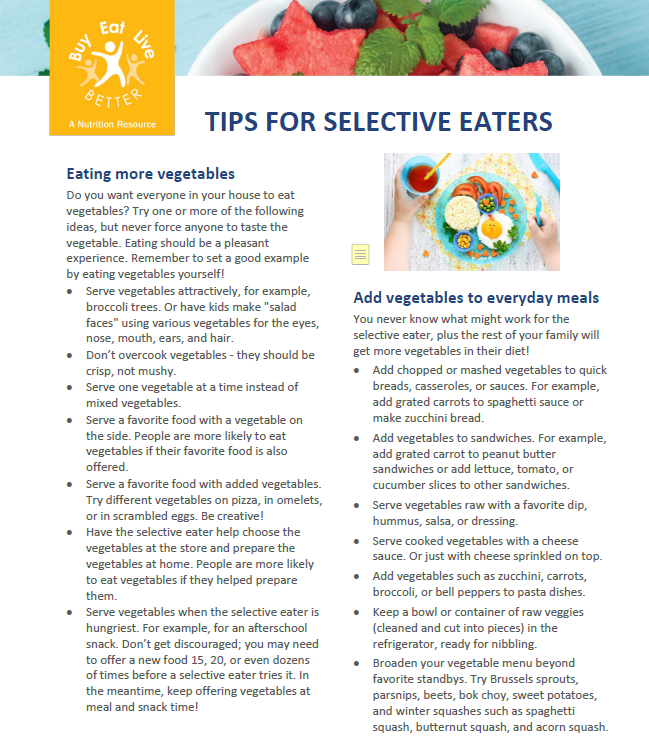Tips for Selective Eaters

Eating more vegetables
Do you want everyone in your house to eat vegetables? Try one or more of the following ideas, but never force anyone to taste the vegetable. Eating should be a pleasant experience. Remember to set a good example by eating vegetables yourself!
- Serve vegetables attractively, for example, broccoli trees. Or have kids make "salad faces" using various vegetables for the eyes, nose, mouth, ears, and hair.
- Don't overcook vegetables - they should be crisp, not mushy.
- Serve one vegetable at a time instead of mixed vegetables.
- Serve a favorite food with a vegetable on the side. People are more likely to eat vegetables if their favorite food is also offered.
- Have the selective eater help choose the vegetables at the store and prepare the vegetables at home. People are more likely to eat vegetables if they helped prepare them.
- Serve vegetables when the selective eater is the hungriest. For example, for an afterschool snack. Don't get discouraged; you may need to offer a new food 15, 20, or even dozens of times before a selective eater tries it. In the meantime, keep offering vegetables at meal and snack time!
Add vegetables to everyday meals
You never know what might work for the selective eater, plus the rest of your family will get more vegetables in their diet!
- Add chopped or mashed vegetables to quick breasds, casseroles, or sauces. For example, add grated carrots to spaghetti sauce or make zucchini bread.
- Add vegetables to sandwiches. For example, add grated carrot to peanut butter sandwiches or add lettuce, tomato, or cucumber slices to other sandwiches.
- Serve vegetables raw with a favorite dip, hummus, salsa, or dressing.
- Serve cooked vegetables with a cheese sauce. Or just with cheese sprinkled on top.
- Add vegetables such as zucchini, carrots, broccoli, or bell peppers to pasta dishes.
- Keep a bowl or container of raw veggies (cleaned and cut into pieces) in the refrigerator, ready for nibbling.
- Broaden your vegetable menu beyond favorite standbys. Try Brussels sprouts, parsnips, beets, bok choy, sweet potatoes, and winter squashes such as spaghetti squash, butternut squash, and acorn squash.
Vegetables are important!
Vegetables are full of nutrients and fiber and usually low in fat and calories. Vegetables make you feel great, give you vitamins and minerals, and lower your chance of getting some types of cancer and heart disease. For good health, most people need 2 1/2 to 3 cups of vegetables each day. What if your selective eater is not eating the recommended amount of vegetables? Don't worry, if you continue to serve vegetables in fun ways, set a good example, and involve the selective eater in food choice and preparation, your child will probably eat vegetables eventually!
Featured Recipes
Apple SmilesSlice apples into wedges.Spread one side of two wedges with peanut butter.Top peanut butter on one wedge with raisins or smallmarshmallows for teeth.Place other apple slice on top. Repeat with remainingwedges. |
 |
Fruity Breakfast WaffleToast waffle. Cover toasted waffle with yogurt and top with fruit. |
 |


 You may require
You may require